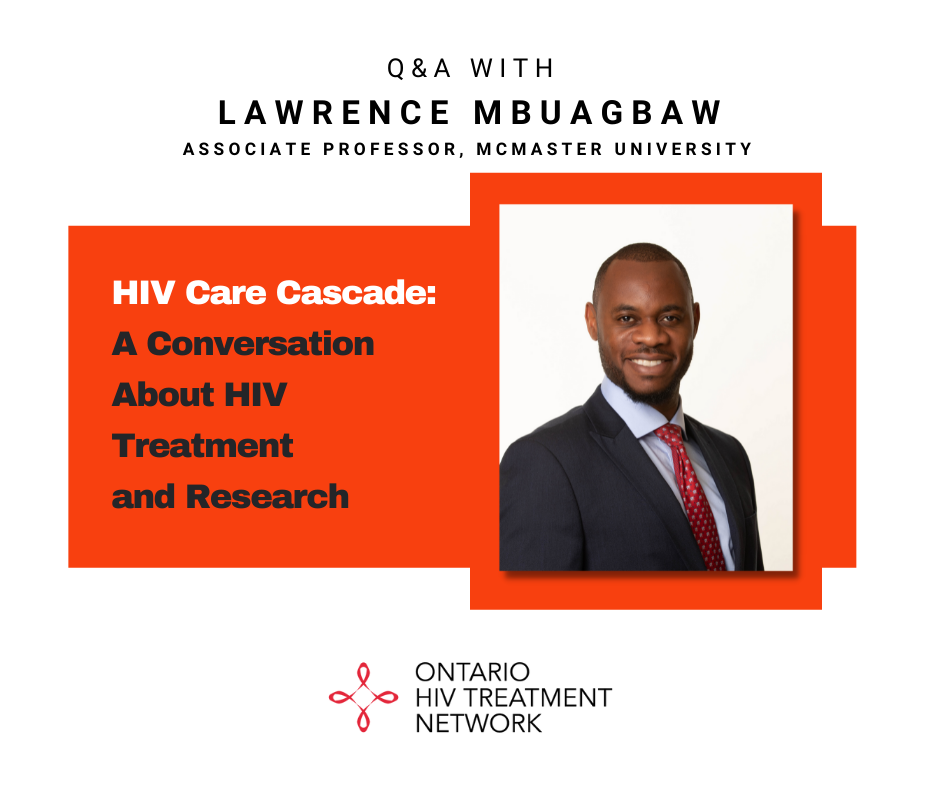Can you please tell me a little about yourself?
My name is Lawrence Mbuagbaw and I am an associate professor at McMaster University and a research methods consultant at St. Joseph’s Healthcare Hamilton. I trained as a medical doctor in Cameroon, studied public health in Israel, and completed a PhD in health research methodology at McMaster University.
I have been working at McMaster since 2014 and lead a program of research on HIV. I am investigating optimal points in the HIV care cascade that can be used to enhance engagement (i.e., initiation of treatment, adherence to medication and retention in care).I am also interested in understanding Black people’s risk of HIV in Ontario.
What is the HIV care cascade?
The HIV care cascade refers to the cascade of events that follow an HIV diagnosis. In principle, after a positive test, an individual who is fully engaged in care can start treatment, be virally suppressed, and live a long life. However, this is not always the case.
For various personal and systemic reasons, people living with HIV may be diagnosed but then not come back for treatment. Some of those who do come back may not adhere to treatment and may not be retained in care. This presents an obvious problem: if antiretroviral treatment is not taken appropriately, then the virus is not suppressed in the person’s system. This compromises their health and longevity.
Can you briefly describe your current HIV research?
The purpose of my HIV research is to inform policy and practice on the best ways to improve the HIV care cascade for people living with HIV, especially vulnerable populations.
There are multiple parts to my research program, which can be summarized in three distinct but related questions:
- Doctors use “resistance testing” to determine if an individual’s strain of HIV is resistant to some of the available drugs. What is the population-level impact of HIV drug resistance testing on mortality, hospitalization, and emergency room visits?
- What interventions improve initiation of treatment, adherence to medication, and retention in care in vulnerable populations in high-income countries?
- What are the barriers and facilitators to implementing effective interventions aimed at improving initiation of treatment, adherence to medication, and retention in care among people living with HIV in Ontario?
Why is the resistance test crucial before starting treatment?
The resistance test permits doctors to determine the most potent treatment for each patient, by avoiding the drugs that may not be effective for them due to drug resistance. Without a resistance test, people with HIV might receive treatments that do not work.
What is the CASCADE database used for?
The CASCADE database is a repository of trials of strategies that have been used to improve the HIV care cascade. This includes trials aimed to improve initiation of treatment, adherence to medication, and retention in care. This data is a byproduct of a systematic review and can be used to learn about interventions, create evidence maps, conduct methodological research, and conduct further systematic reviews.
Why do some interventions work in research and not in real life?
Many interventions, especially interventions tested in trials, may not work in real life because they are too costly for service providers, too resource intensive for health workers, or too burdensome for people living with HIV. The nature of the research setting is also different than in the real world, where patients may have to pay for some services, have other comorbidities to consider, and where patients are not followed up as stringently as in a research setting.
What is the most surprising thing you discovered while doing your research?
The most surprising thing I found was the lack of evidence on the HIV care cascade in vulnerable populations (ethnic minorities, linguistic minorities, men who have sex with men, people who inject drugs, sex workers, women, youth, people in prisons, immigrants, refugees, and no-status people); there are very few studies conducted.
Based on what you learned through this study, what interventions work best and why?
The interventions reported to be most effective across the continuum of care were:
- Interventions with multiple components, where several approaches are combined (such as peer navigation, counselling, and education packaged as one intervention).
- Peer or community-based interventions, which take place in the community as opposed to health facilities (such as HIV treatment services or community antiretroviral therapy refill services).
We have also learned from our mixed methods study, which is a study done with HIV health workers and people living with HIV in Ontario, geared to uncovering what kinds of strategies are in place for improving initiation, adherence, and retention in treatment and care, as well as which are preferred, and why.
In this study, the most frequent reason given by health workers for not implementing some interventions was to do with a lack of skills or resources, their clinic not being the right setting for the interventions, or that the intervention did not reflect the clinic’s usual care. The “usual care” is the standard practice in each clinic; interventions that are disruptive of usual processes or require significant changes to the workflow and resources are less likely to be adopted.
HIV clinics are already doing several things to improve the care cascade. Some of these include education, counselling, linkages to support, frequent follow up, outreach, and hosting support groups to name a few.
If people want to learn more about your research, or the CASCADE database, where can they go? Anyone interested in learning more should visit my personal website: http://lawrencembuagbaw.ca/ the CASCADE website: http://hivcascade.com/ or the A/C study website: https://acstudy.ca/
